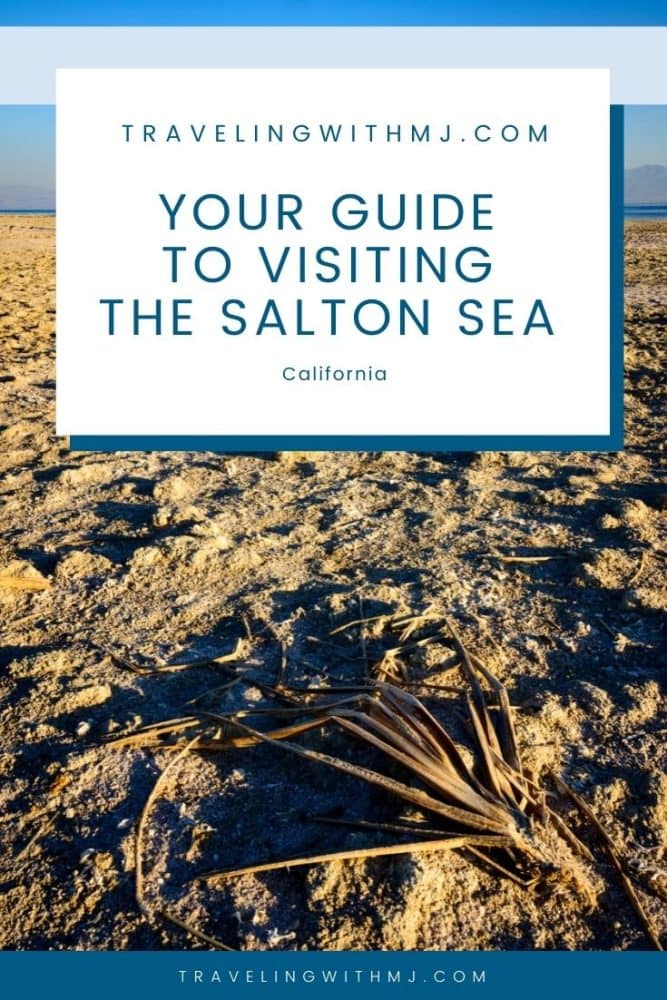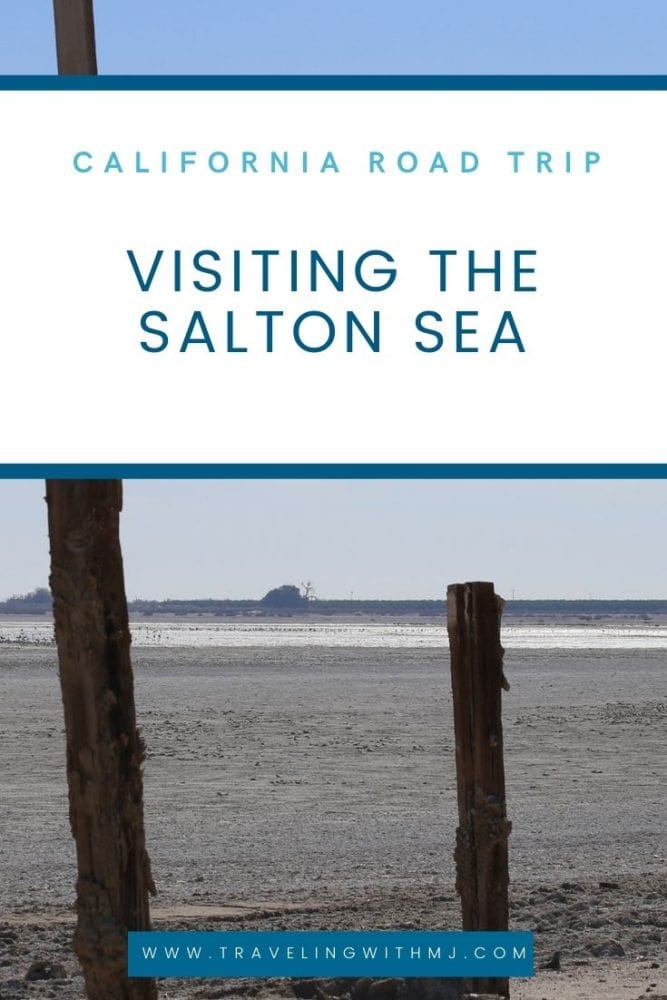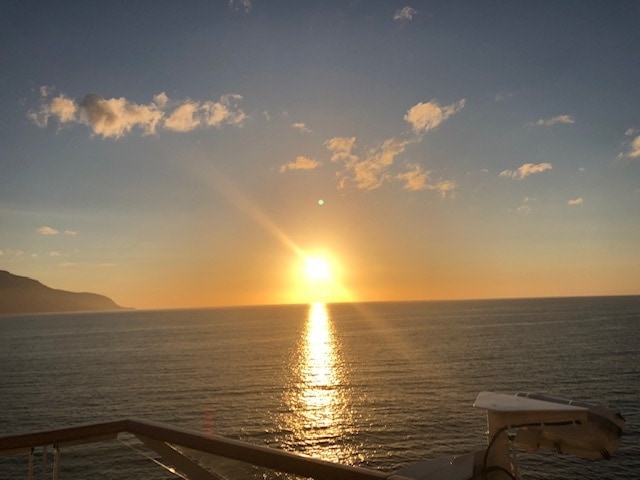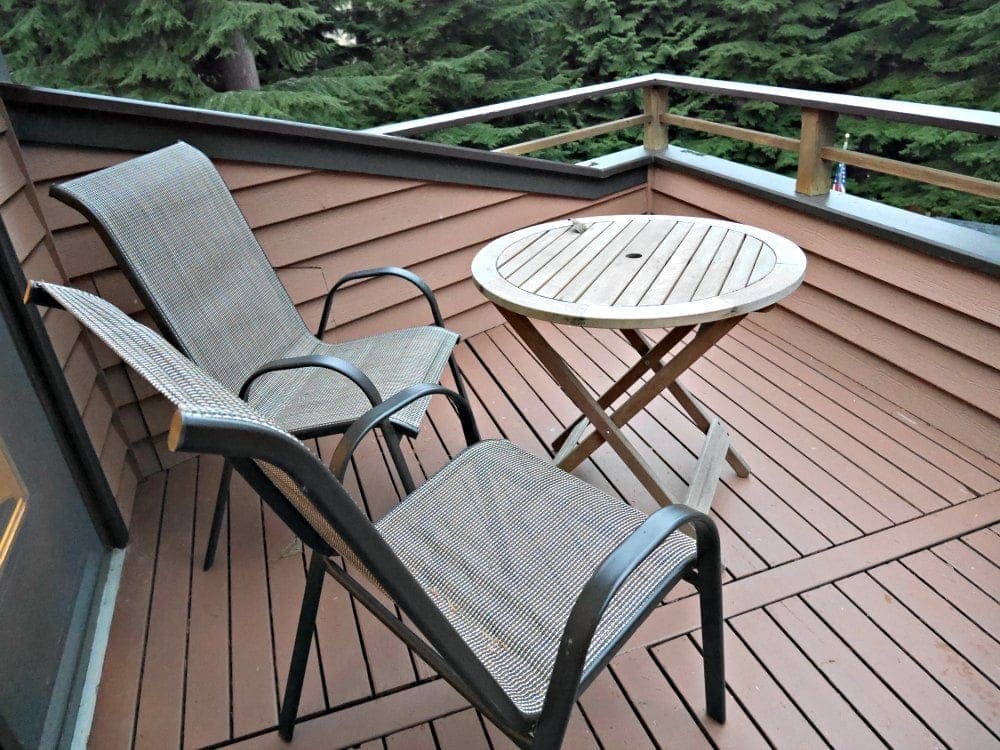The Salton Sea is one of the most environmentally significant places in California. It was once a booming tourist destination and attraction, but turned into an environmental disaster, leaving much of the surrounding towns and settlements abandoned and desolated.
But that does not mean to suggest that it’s not worth visiting the Salton Sea. Today, the Salton Sea attracts visitors wanting to experience its volcanic mud hot springs, observe the unique wildlife, and also swing by the famous Slab City, a lawless town that features many art installations.
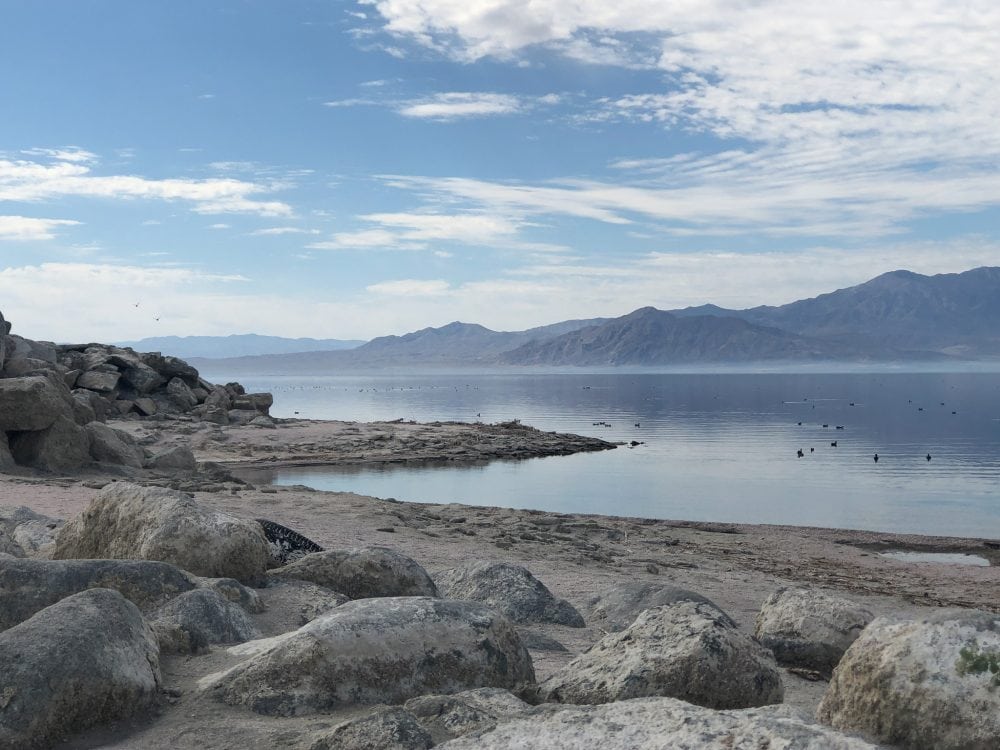
For those undertaking a road trip through California, visiting the Salton Sea is definitely something to add to the itinerary. I had never heard of it, but while visiting Palm Springs, a friend suggested it as a day trip. I thought it was a great little escape into nature, and thought about what it must have been like in its heyday.
[toc]
The History of Salton Sea
The Salton Sea is California’s largest lake and it used to be a bustling tourist attraction. However, today it is a desolate, remote place in the desert. The history of the Salton Sea is quite a sad story, highlighting the grotesque consequences of climate change and human impact on the environment.
The lake was formed over a thousand years ago when the Colorado River spilled over into the Salton Basin creating intermittent lakes. Over the years, the freshwater lakes evaporated into the basin and became a desert, then were refilled again during rainstorms.
However, after human intervention, the Salton Sea changed, eventually becoming what it is today.
In 1901, the California Development Company dug irrigation canals from the Colorado River to supply water to the valley of California. However, engineers cut too much from the bank and heavy floods rushed into the valley, creating the Salton Sea lake.
By the time the breach was fixed, the Salton Sea had already formed into a huge lake. Since there was no runoff or drainage for the lake, the water was unable to leave and became stagnant. Some water evaporated, but the additional runoff from agricultural farming continued to add to the lake, which meant that the water level was constantly maintained.
For a time, the ecosystem thrived. The water coming from agricultural runoff allowed many species of birds and other wildlife to flourish around the lake. By the 1950s, Salton Sea was a successful resort area, attracting Hollywood celebrities in addition to families and well-to-do locals.
Unfortunately, the fertilizer in the runoff resulted in eutrophication, an excessive richness of nutrients in the water, and that caused large algae blooms to form and bacteria to grow. Eventually, the lake began to turn saline from these conditions, and in 1974, the State of California began to talk about how to reduce the salinity of the lake.
By the 1980s, the lake was producing a putrid and noxious smell, and the smell of rotting fish began to not only repel tourists but the residents, too. With a few more years, the salinity of the Salton Sea had reached a hypersaline state, a term used to describe a body of water saltier than the sea. The State of California began advising people not to eat the fish from the lake. As the lake became more and more polluted – and smelly – tourism continued to decline.
By the 1990s the salinity had increased again, continuing to cause catastrophic effects on the wildlife. Approximately 150,000 eared grebes died as a result of the salinity of the lake, and 7.6 million tilapia and croakers suffocated from lack of oxygen that had been depleted by the algae.
Over the last twenty years or so, officials have discussed trying to save the lake, but after years of political ping-ponging of responsibility, nothing has been done.
Today, only a few people live near the Salton Sea and most of the towns around it remain abandoned. The Salton Sea State Recreation Area is still open on the northeastern side for hunting, fishing, swimming, and camping.
Things to Do and See at the Salton Sea
While the Salton Sea is mostly desolate land, there are still things to see and do in the recreational area. It’s always best to plan ahead, and double-check websites and information sources because many places are closed during the off-season or on weekdays.
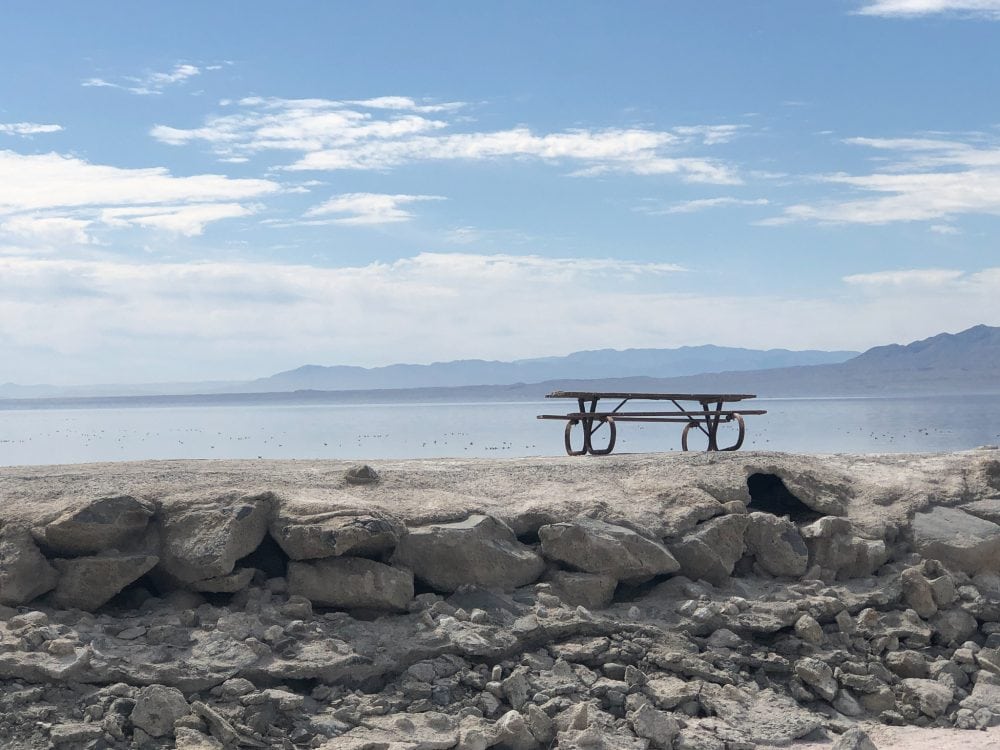
Visitors should note that there is an entrance fee for the day-use area of $7 for sightseeing, fishing, picnicking, and birding. When we visited in the early Covid days, the fee was not being charged nor enforced.
If you want to camp, it will cost you $20 to access campsites plus $30 to hook up your RV. More details about fees can be found on the Salton Sea park webpage.
Salton Sea Visitor Center
A must-stop on a visit is the Salton Sea State Park Visitors Center. This is where you can find information on the history of the lake and its surroundings, and is a great place to start your visit. It’s full of maps, guidebooks, and background information. Since we knew little about the Salton Sea or the surrounding area, we picked up important information for the visit. There are also plenty of things to buy – books, t-shirts, coffee mugs, stuffed animals – with proceeds benefiting the area.
The visitors center is only open during peak seasons from Wednesdays-Sundays.
Birding at Sonny Bono Bird Area
While many birds perished in the past due to the toxicity of the lake, some species still remain. If you’re interested in bird watching, then there is a platform at the visitors center that is ideal for viewing the birds. Another great spot to look for birds is from the hiking trail that overlooks the beach and lake. The area is named for Sonny Bono, former Palm Springs Mayor who championed the restorations of the Salton Sea.
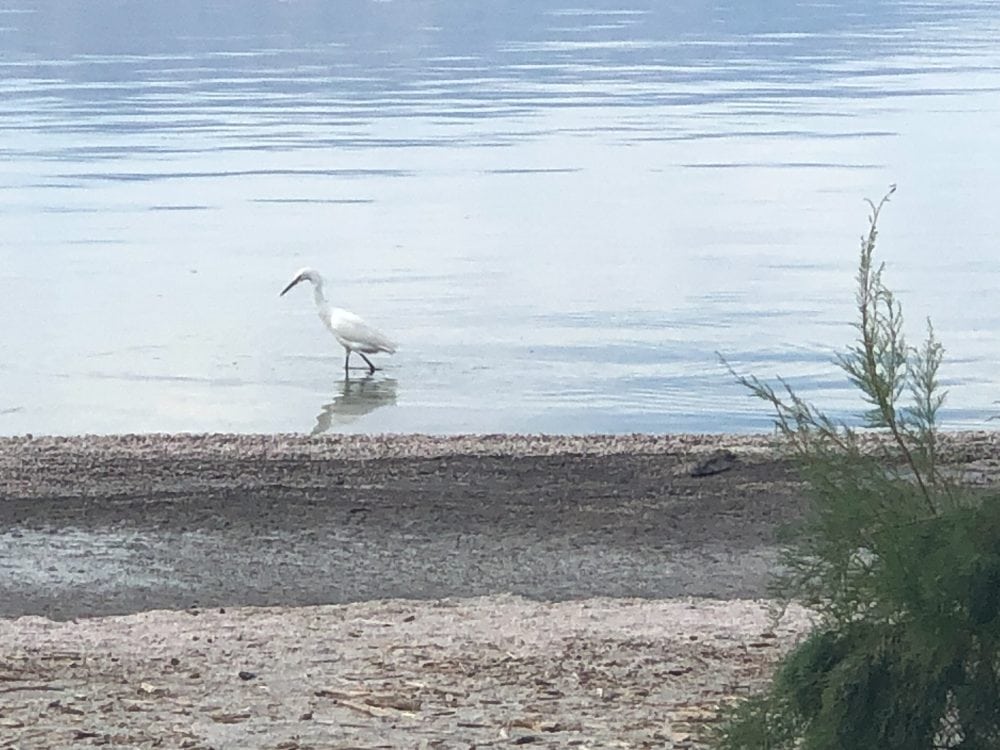
Birds tend to migrate to the lake during the winter months (November-February), which is the ideal time to see them. On a future visit, we’ll be sure to bring along binoculars.
Fun fact for those who may not remember: Sonny Bono was the husband of Cher, and the couple was a popular recording duo, Sonny and Cher.
Fishing in the Salton Sea
While it is no longer possible to go boating at the Salton Sea due to declining water levels, it is still possible to fish at the Salton Sea. Due to the high saline content and toxicity of the lake, any fish you catch should be thrown back into the lake and not eaten. Today, though, only the desert pupfish survives in the sea and is listed as an endangered species in the United States.
Fishing requires a $7 entrance fee from the Salton Sea State Recreation Area Headquarters where you will also find a fishing jetty.
The best time of year to go fishing is in the summer months (June-September). Be sure to bring a hat, plenty of water, and sunscreen. The weather is hot and can be brutal.
Salton Sea Bubbling Mud Pools
One of the most remarkable sites in the Salton Sea area is the volcanic bubbling mud pools, which are connected to the Salton Buttes – a group of five volcanoes in the state of California. The pops of mud can reach several feet in the air.
The volcanic bubbling mud pools are not the easiest of the Salton Sea tourist attractions to find, which is why we missed them. Next time, we sleuth them out.
To find the mud pools, you need to head towards a big field at the intersection between Davis Road and Schrimpf Road on the southeast side of the Salton Sea. It is roughly a mile and a half away from Mullet Island. There are also mud pools on Mullet Island, but they’re gated off to keep vehicles away.
When looking for the mud pools, you’ll need to be careful as they are not fenced off and are just a short distance from the road. You’ll know when you find them, as you’ll see large mud formations that protrude from the ground. Note that the road surface can be wet in some places and mud can stick to your tires. Drive slowly and carefully.
The pools are impressive, but not without their dangers. They are volcanic, which means they are very hot. Do not climb on the mud volcanoes or touch the mud pool. This area is not suitable for pets or children.
Bombay Beach Ruins
Back when the Salton Sea was a thriving resort town, Bombay Beach was the place to be. However, today it is home to discarded homes, trailers, and businesses, that have lain abandoned for the last 30-years.
Walking around the ruins of Bombay Beach is both haunting and fascinating at the same time. Photographers will love the unique effects of decay that are left on these structures. However, it’s not all a state of rot. The town has become a project for artists who have each taken a building and turned it into something unique, changing it from a remote desert ghost town into an arts district.
Art Installations of Slab City: The Sole Tree, Gemstone Truck, Salvation Mountain, East Jesus
And it’s not just the Bombay Beach area that has artists inspired.
Be sure to allocate time to wander around all the art installations in Slab City, a small lawless town in the southwest area of the park. In Slab City, you’ll notice the colorful and ornately decorated buildings before you even enter. From iron sculptures to hand-painted buildings, this is like a permanent Burning Man city.
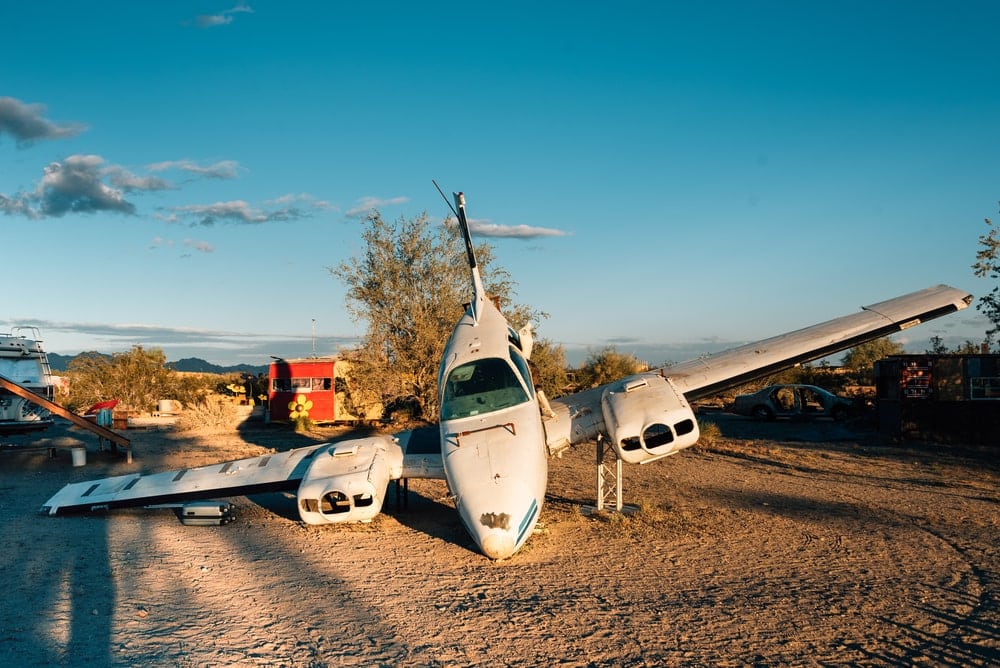
One of my favorite art installations in the city is the Sole Tree – a tree full of shoes. Opposite the tree is a gemstone truck, a truck covered in gemstones. Other popular art installations are the Salvation Mountain, a colorful piece of ‘slab art’ by Leonard Knight, who spent 25 years creating this incredible site that can be seen from the entrance to the town.
East Jesus is a labyrinth of cars, sculptures, and buildings. The artist, Charlie Russell, wanted to create an economical and habitable art installation. Take a visit and see how well you think he did.
International Banana Museum – The Most Quirky Place to Visit at the Salton Sea
The International Banana Museum is one of the more unique Salton Sea attractions and it is exactly what it sounds like. The one-room museum of banana-related merchandise holds the world record for the most banana-related merchandise (25,000 items).
From the outside, it is connected to a convenience store for the local campground, but it is easily distinguishable by the sign and the banana sitting in the chair.
The Museum is open, hours are 1-5:30 pm, Saturday, Sunday, and Monday. Admission fees are located on their website.
Where is the Salton Sea and How to Get There?
The Salton Sea spans across southern Riverside and northern Imperial counties in Southern California on the Pacific Flyway.
Driving from Los Angeles, take US-101 South towards Idaho, and then move onto CA-86 South towards Salton City. The CA-86 takes you along the west coast of the Sea. You can stop at Desert Shores, Salton Sea Beach, or continue on to Salton City.
Driving from San Diego, take I-8 East, then turn onto CA-79 North and on to CA-78 East. This will take you to the CA-86 which goes along the west coast of the Salton Sea as explained above.
Parking lots are open at Mecca Beach, Corvina Beach, and Salt Creek.
What People Ask About Salton Sea
Can I swim in the Salton Sea?
No. Because of the toxic algae outbreak in the water, the California State Water Resources Control Board does NOT recommend swimming in the Salton Sea.
Is the Salton Sea Worth Visiting?
Yes, Even though you cannot swim in the lake, it is definitely worth visiting. The desolate towns surrounding the lake, such as Slab City and Bombay Beach are home to some wonderful art installations. Visiting the birding area gets you a look at some of the wildlife in the area. And visiting is a close up look at the drastic effects of climate change firsthand
Why is the Salton Sea Abandoned?
Because of the toxicity of the lake and the putrid smell it creates, tourism stopped flooding the area. As a result of the declining tourism, the residents began to leave too. Pretty soon, no one was left.
Final thoughts on Visiting Salton Sea
Though it has a sorrowful history, the Salton Sea is an important landmark in the state of California and has some incredible natural phenomena to witness. The volcanic mud pools are just one example of how primitive this area still is.
Although the towns have been left abandoned and in a desolate state, there is a silver lining. This once-popular vacation destination for Hollywood stars is now an artist’s playground. It’s once again become a unique and spectacular place to visit.
More California Road Trip Ideas
If a California road trip is in your plans, you might find these guides full of ideas.
For Pinterest
Save this to your favorite Pinterest boards to plan your next California road trip.
